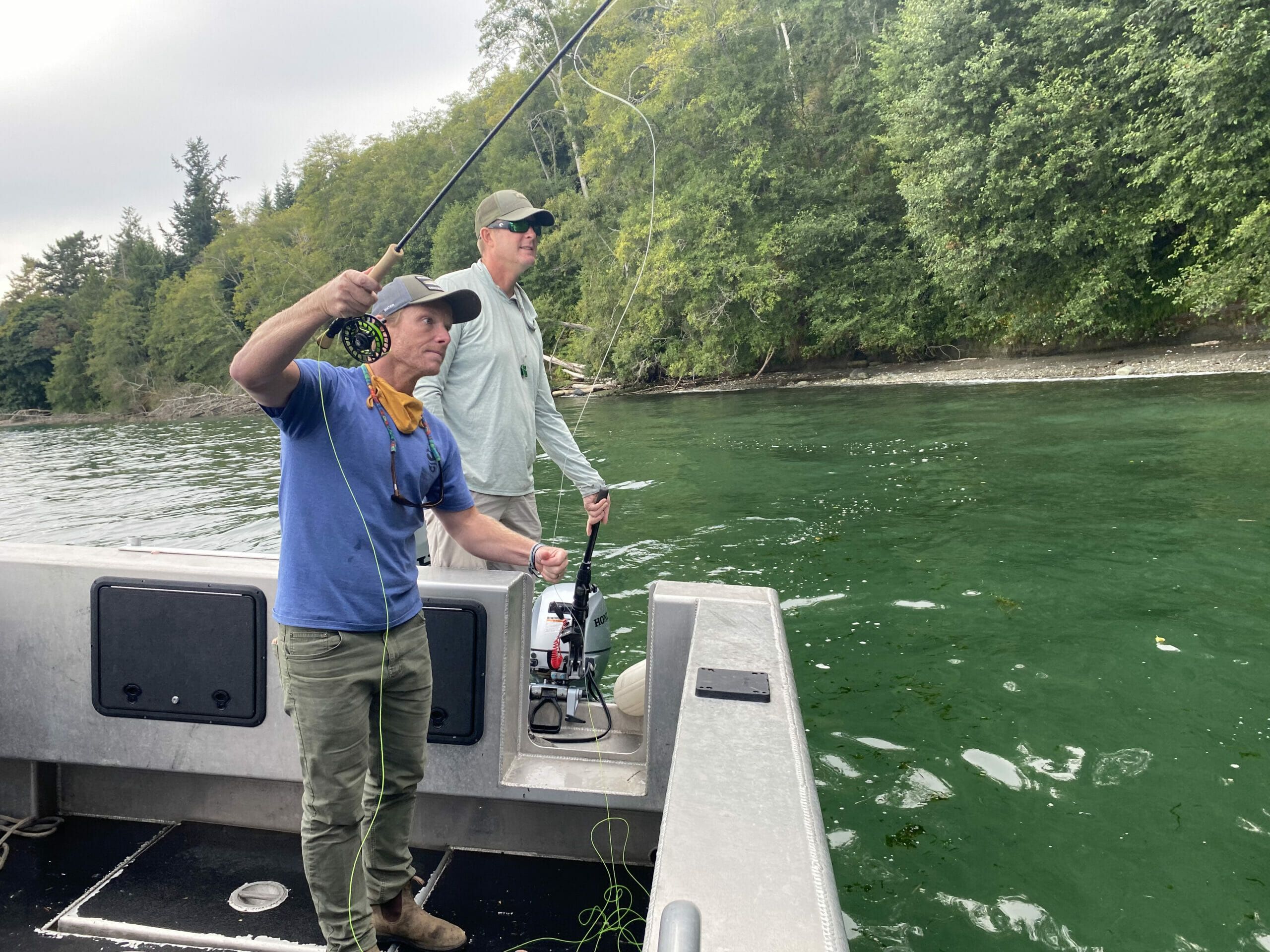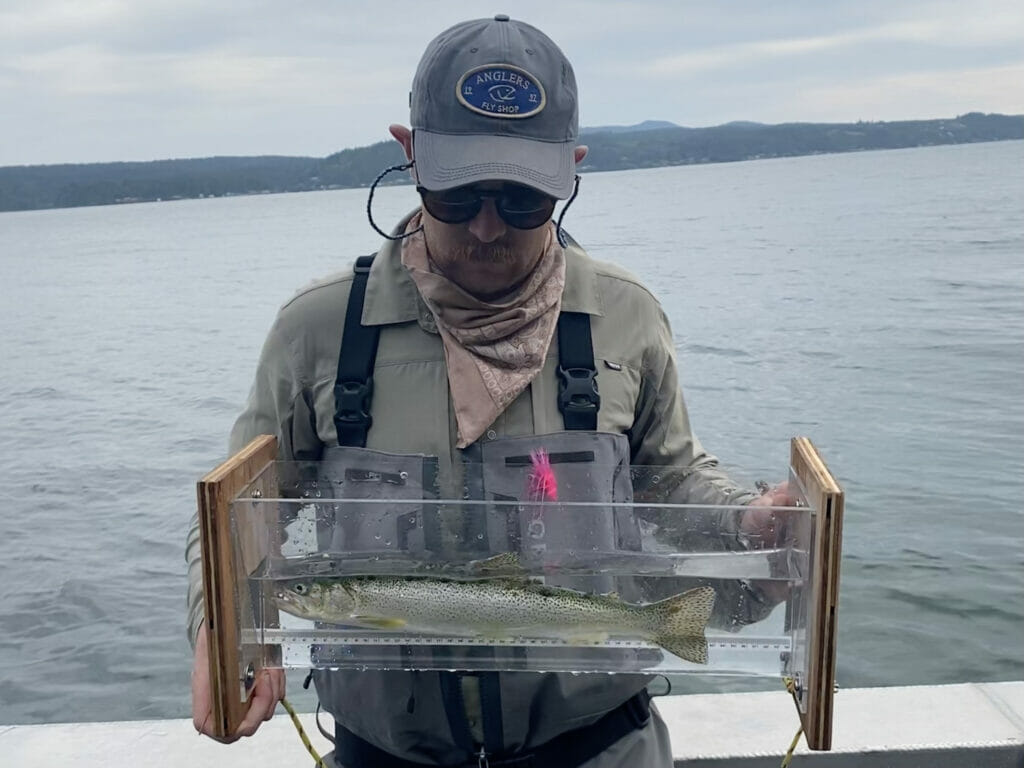How citizens and scientists are joining forces in Washington to fill in the blanks on coastal cutthroat trout
Editor’s note: Daniel Ritz is fishing across the Western United States this summer in an attempt to accomplish the Master Caster class of the Western Native Trout Challenge. He will attempt to land each of the 20 native trout species in their historical ranges of the 12 states in the West. You can follow Ritz as he travels across the West by following Trout Unlimited, Orvis, Western Native Trout Challenge and Montana Fly Company on social media using the #WesternTroutChallenge.
If you read this book by it’s cover, you might see James Losee and Greg Shimek as an unlikely duo.
These native Washingtonians, separated by almost 40 years in age, serendipitously found each other through their shared passion for coastal cutthroat trout. This dynamic and biologically unique subspecies, containing each of the four life cycles of trout (anadromous, fluvial, adfluvial and resident) have long captivated the two equally energetic men.
Together, they are on the frontier of the scientific understanding of this trout and likely hold the keys to unlocking its future.
In late August, I met Losee, the Region 6 (coastal) Fish Program manager for Washington Department of Fish and Wildlife (WDFW) near his home in Olympia, Wash., before driving north toward the Hood Canal to join Shimek and Capt. Chad Gillespie of Fjord Fly Fishing.
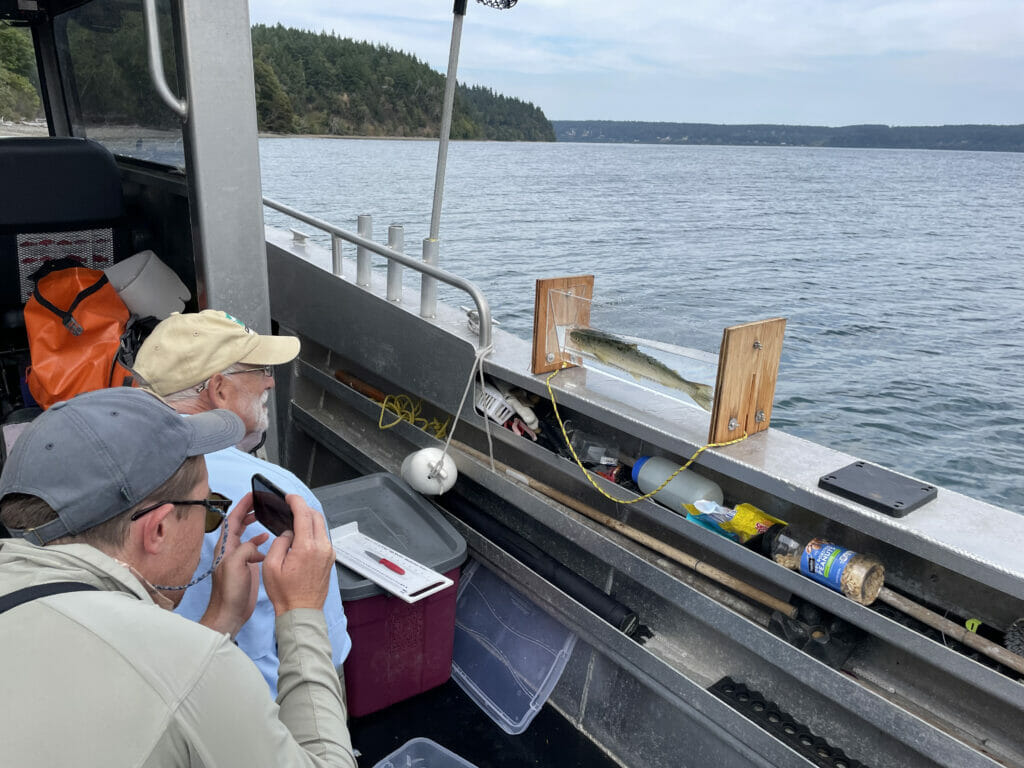
Gillespie is a soft-spoken part-time fishing guide in the Hood Canal. Full-time, he works as a fireman. He also casually designed and had the boat we fished from custom made from more than 3,500 pounds of sheet aluminum. A lifelong Hood Canal angler, he donates his experience, equipment and lethal angling skills to the citizen science project on which we were embarking. Cool, calm and confident, Gillespie carries himself as the sort of angler that would outfish the pro staff without breaking a sweat and then kindly offer to fix their boats for them.
“I caught cutthroats when I was kid from these same banks and beaches,” Gillespie responded when I asked why he volunteers his valuable time and resources to Losee and Shimek’s research. “I self-taught myself to fly fish on cutthroats. I want that for my kids. I want these fish to be around for the next 100 years — more.”
Together, we were to spend a day on Gillespie’s boat in the Hood Canal surveying for coastals with hook and line for the Big Fjord Project, a collaborative effort funded by a grant awarded to project leads WDFW, Coastal Cutthroat Coalition, Hood Canal Salmon Enhancement Group and the Western Native Trout Initiative by NOAA. The project intends to fill crucial gaps in fundamental scientific data regarding one of Washington’s only two native trout cutthroat trout species.
In the first phase of the project, volunteers and project staff walked hundreds of miles of streams surrounding Hood Canal to gather DNA samples from freshwater coastal cutthroats. This was done to have a baseline to compare to the adult samples that we were hoping to catch during our day on the water.
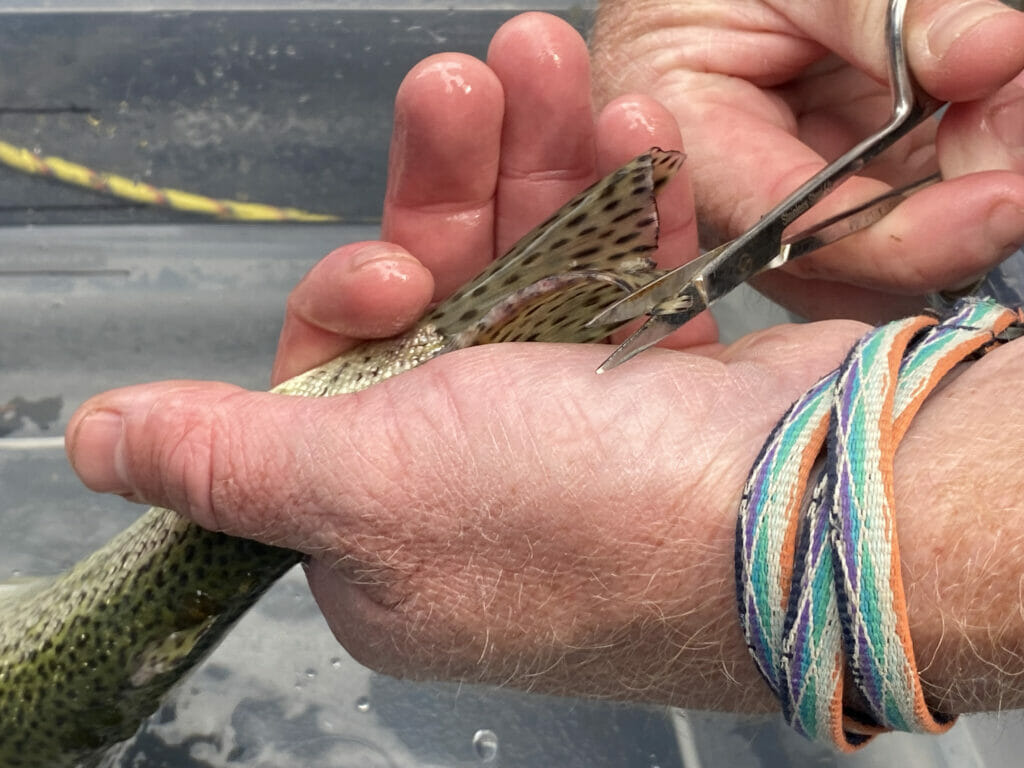
Led by Gillespie, we were to fish one carefully segmented portion of the canal, conspicuously labeled only as section “G,” and hopefully catch adult specimens to then cross-reference with the DNA gathered from the streams to learn behaviors including movement, spawning, habitat preferences and more. Every quarter, for the entirety of 2021, project partners will survey each of these segments of the canal in order to gather data from each portion of the fishery.
The third portion of the project, which they hope to begin in 2022, is to use the data from the DNA samples to identify and strategically restore crucial spawning habitats in the freshwater tributaries surrounding the canal. This is particularly interesting, as coastal cutthroats have previously been traced to very specific freshwater streams for spawning purposes. Losee mentioned a previous study where an extraordinarily high percentage of cutthroats found in a marine environment fed by three freshwater tributaries could be traced back to only one of those three streams.
If this all sounds like basic knowledge needed for sound fisheries management, you are right. In Washington, the once abundant coastal cutthroat trout, egregiously formally known as the “harvest trout” by anglers, was so bountiful and easy to catch in the coastal waters of northwestern Washington that Losee mentioned a time when the regulation on harvest was “a bucket plus one.” Somewhat understandably, at least regarding economics, the gamefish has historically fallen down the priority list compared to the five species of Pacific salmon and steelhead found throughout the waterways of the state.
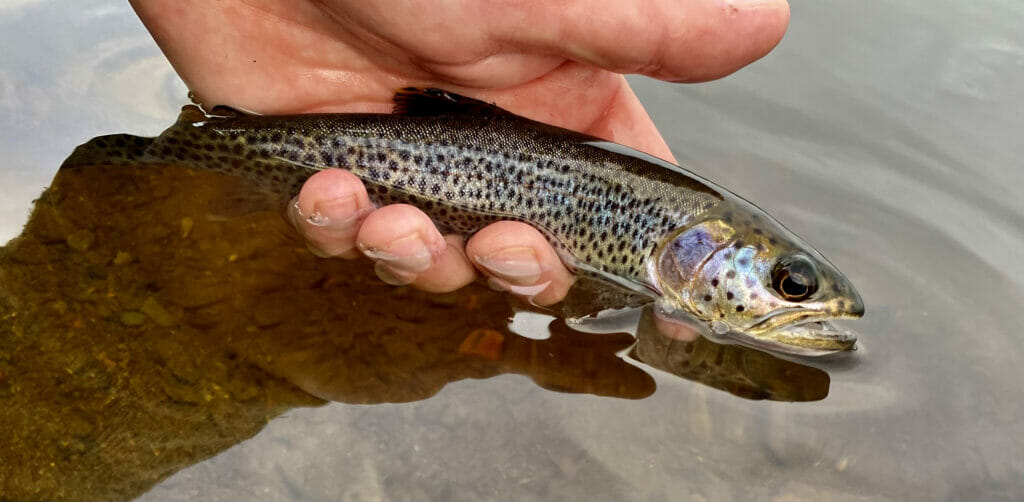
Shimek, who caught his first cutthroat in 1958 in waters not far from where we launched Gillespie’s boat, says while there is minimal historical scientific data to support his claim, anecdotally, he can and will testify firsthand to the dramatic decline of the cutthroat.
As Shimek explained his experience, standing on the casting deck on the bow of Gillespie’s boat, I realized this narrative encapsulated a lot of the character of Shimek. Kind, and caring, Shimek stands tall as the energetic old timer who knows something—he deeply knows something to be true, but he needs help proving it. He resonates a trustworthiness that obviously invigorates Losee’s borderline rabid and highly contagious energy.
Within mere minutes, Gillespie had the first cutthroat of the day on the line. Quickly getting the fish to the boat, Shimek and Losee took the fish from the net and deposited it into a tank to have scales scraped and fin clip samples taken. Even before the fish is fully submerged in the tranquilizing solution to pacify it, Gillespie has his shrimp imitation back in the water. Watching him, he resembles a sort of an ironic angelic mercenary.
After the first fish — we were hoping to catch six from this section, the minimum needed for a representative sample size — we suffered a long gap before the next.
As Gillespie expertly guided us through the shallow drop off zones, we casted shrimp and small baitfish imitations towards the bank, stripping them with abandon back to the boat. The lack of action was initially off-putting as I knew coastal cutthroat are known for what is called high fidelity.
“These (study) results suggest that O. c. clarkii occupying south Puget Sound reside in or regularly return to a small geographic area in the nearshore environment for much of their life and therefore may be particularly vulnerable to anthropogenic disturbance (development, angling, etc.),” Losee states, based on the findings from a study done in 2018.
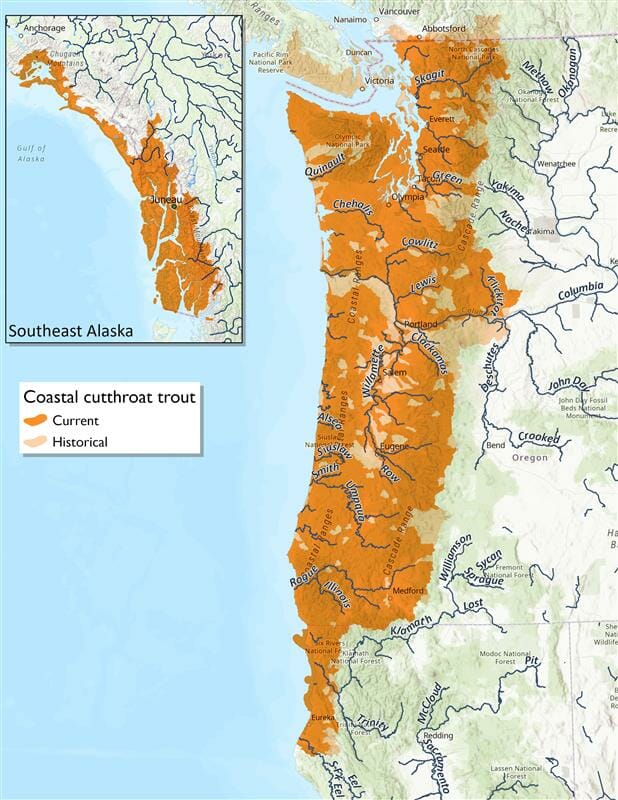
Translated to standard American English, while the high “catchability” of coastals could appear to be a net positive for anglers, Losee and Shimek note that this can also misrepresent population numbers.
“You can tell a lot of these fish have been caught a number of times,” Shimek explained as Gillespie put the second fish of the day into the net. “Often, people will think that because they caught a lot of fish that there are large numbers of fish. We suspect that often anglers are catching the same fish again and again.”
Fidelity aside, Losee and Shimek attempted to comfort my growing anxiety caused by not yet catching the species I had driven more than 600 miles from home to catch, by explaining that this was also the hardest time of the year to find cutthroat.
After another hour or so, I switched to a sinking line to ensure I stayed down in the water column during my retrieval. It wasn’t long until one of my strips was met with the slightest resistance. I set the hook, and with a subtle shake I knew that I had a fish on.
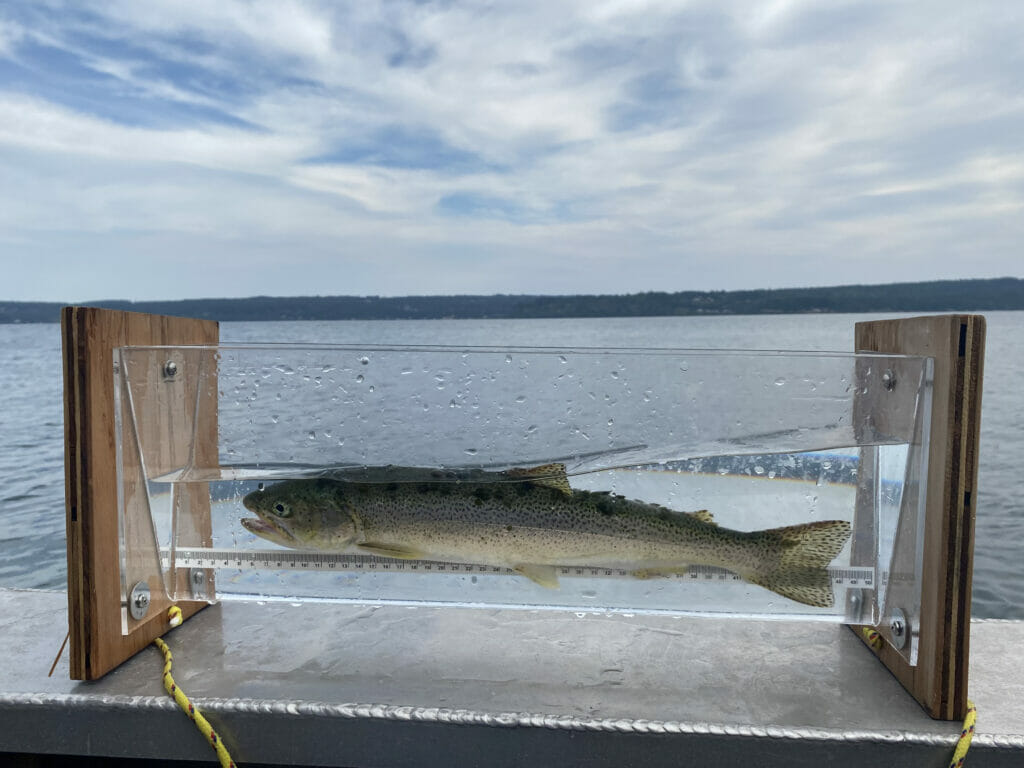
“We’ve got one! I need a net up here,” I yelled as the boat immediately erupted in activity.
In a moment that revealed more of his character than I bet he realized, Losee rushed to net the sizable cutthroat at the end of my line, almost throwing himself over the bow of the boat in the process. We managed to land the fish together, Losee holding the net and me holding Losee by his belt as he balanced on the railing of the boat, his feet suspended high in the air behind him.
“I would have held on to that fish,” Losee told me after. I had no doubt.
My cutthroat, measuring almost 18 inches, was the largest of the day. I was especially smitten when Shimek told me that he himself had never caught a 20-inch cutthroat.
While the unknowns surrounding coastal cutthroat trout can appear glaring, Losee and Shimek hold hope for the future.
Losee mentioned a number of streams where populations boomed after regulations transitioned to catch and release only. Currently, in Washington, no coastal cutthroat trout can be harvested in salt water but can be harvested in select freshwater streams.
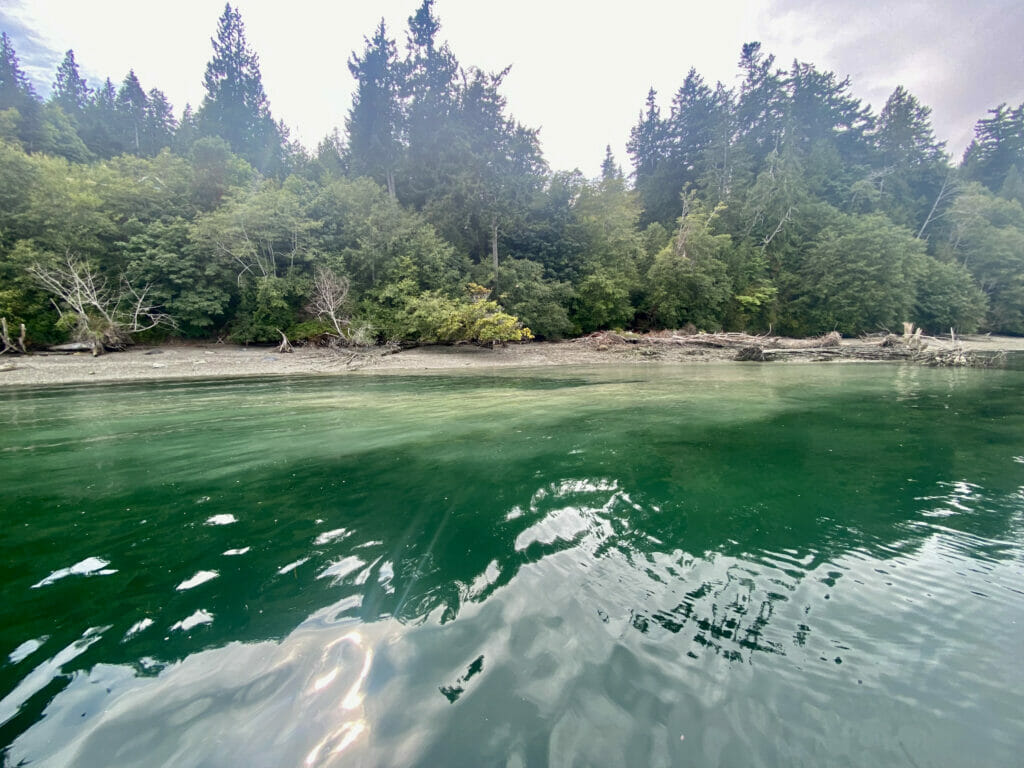
When it comes to his beloved coastals, Shimek holds a refreshingly open-minded and optimistic perspective.
“The coolest part of the new angling community is that all sorts of people are interested in them,” Shimek laughed to himself in an inspiring moment of self-awareness. “It’s women and children, new anglers, people of color. It’s skateboarders and people with rings in their noses. We have a real opportunity to educate this new community to make sure that the future is different from the past.”
“It’s me,” Shimek continues, pointing to his chest. “…it’s the people like me that are used to doing things the way they have always been done and we simply can’t do that any longer.”
Another unique aspect of the new attention to these cutthroats is the rapidly increasing pressure from guides and anglers who historically have been highly engaged in the Northwest’s salmon and steelhead fishing community.
“As salmon and steelhead runs diminish, there’s a lot of guides and anglers looking for new opportunities,” Gillespie added.
Together, Losee, Shimek, their respective teams and supporting partners are looking to create a baseline of science to assist future fish managers make decisions to ensure the continuance of the species.
After our day on the water, I asked Losee and Shimek the same question.
“Is there a way, a metric, that you would be satisfied with achieving with your work? At the end of the day, what would you feel satisfied with?” I asked.
Independently, they both gave the exact same answer.
“We need to know the population size. We need to know what we’re working with to put all this work to use. To know what we need to do, we need to know what we’re working with.”
“Well, I’m glad we’re on the same page,” Losee chuckled on our ride home when I told him Shimek had said the same thing.
To be completely honest, after my day with them and Gillespie on Hood Canal, I’m not sure I’ve ever met two men more on the same page.
That page would be the cover of the book they are asking the angling community to help them write.
It would appear coastal cutthroat trout were some of the last native species in Washington to receive the attention they deserve, but, thanks to partnerships like Shimek and Losee’s, they will no longer be the least.



